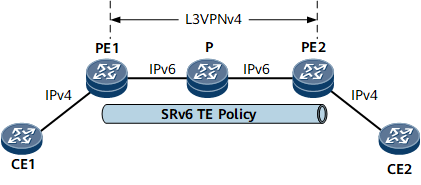Configuring L3VPNv4 over SRv6 TE Policy
This section describes how to configure L3VPNv4 over SRv6 TE Policy.
Usage Scenario
L3VPNv4 over SRv6 TE Policy uses public SRv6 TE Policies to carry L3VPNv4 data. The implementation of L3VPNv4 over SRv6 TE Policy involves establishing SRv6 TE Policies, advertising VPN routes, and forwarding data.
As shown in Figure 1, PE1 and PE2 communicate through an IPv6 public network. The VPN is a traditional IPv4 network. SRv6 TE Policies can be deployed on the IPv6 public network to carry L3VPNv4 services on the VPN.
Pre-configuration Tasks
Before configuring L3VPNv4 over SRv6 TE Policy, complete the following tasks:
Configure a link layer protocol.
Configure network-layer addresses for interfaces to ensure that neighboring devices are reachable at the network layer.
Procedure
- Configure IPv6 IS-IS on each PE and P. For details, see Configuring Basic IPv6 IS-IS Functions.
- Configure a VPN instance on each PE and enable the IPv4 address family for the instance.
- Configure IPv4 route exchange between the PE and CE. For details, see Configuring Route Exchange Between PEs and CEs.
- Establish an MP-IBGP peer relationship between the PEs.
- Configure the device to carry SIDs in VPN routes.
- Configure an SRv6 TE Policy. For details, see Configuring an SRv6 TE Policy (Manual Configuration) or Configuring an SRv6 TE Policy (Dynamic Delivery by a Controller).
- Configure VPNv4 routes to recurse to the SRv6 TE Policy.
Verifying the Configuration
After configuring L3VPNv4 over SRv6 TE Policy, verify the configuration.
Run the display segment-routing ipv6 locator [ locator-name ] verbose command to check SRv6 locator information.
Run the display segment-routing ipv6 local-sid { end | end-x | end-dt4 } [ sid ] forwarding command to check information about the SRv6 local SID table.
- Run the display ip vpn-instance vpn-instance-name tunnel-info nexthop nexthopIpv6Addr command to check information about the tunnel to which the route with the specified next hop recurses in each address family of the current VPN instance.
- Run the ping srv6-te policy { policy-name policyname | endpoint-ip endpointipv6 color colorid | binding-sid bsid } [ end-op endop ] [ -a sourceaddr6 | -c count | -m interval | -s packetsize | -t timeout | -tc tc | -h hoplimit ] * command with the policy-name policyname, endpoint-ip endpointipv6 color colorid, or binding-sid bsid parameter to initiate a ping operation on the specified SRv6 TE Policy for connectivity check.
Run the ping command to check the connectivity between CEs.

